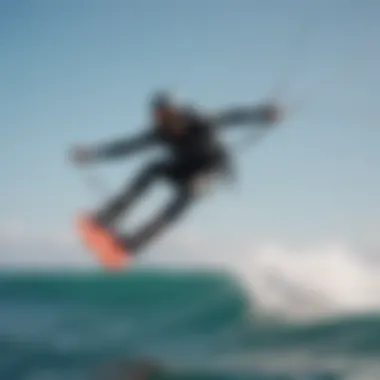Exploring the Slingshot Surfboard: Design and Insights


Intro
Kiteboarding has seen a surge in popularity, drawing in adventurers and water sports enthusiasts alike. Among the range of surfboards available in the market, the Slingshot surfboard has carved out a notable space for itself. This article aims to dissect the critical components that make up the Slingshot surfboard, shedding light on its design, performance, and the various ways it can cater to both newcomers and seasoned riders.
Understanding the nuances of surfboard technology is vital for anyone looking to enhance their skills or simply enjoy a day on the water. The Slingshot surfboard stands out not just for its sleek design and performance capabilities but also for features that align with the needs of different kiteboarders. Whether you're a beginner struggling to find your footing or an expert aiming to master a complex trick, there's something valuable here for everyone.
So, let’s navigate through the specifics of Slingshot surfboards, exploring aspects that contribute to an unparalleled kiteboarding experience.
Preface to the Slingshot Surfboard
Understanding the Slingshot surfboard is not just about picking a piece of equipment; it’s about embracing a lifestyle of adventure and thrill that kiteboarding brings. These boards are finely crafted tools that have the power to transform water sports experiences. Kiteboarding, a blend of surfing, windsurfing, and paragliding, demands equipment that is not only functional, but also innovative. The Slingshot surfboard stands out in this regard, tailored to meet the needs of both novices and experts.
One significant aspect of the Slingshot surfboard is its design aimed at maximizing rider performance and comfort. The unique combination of materials used in its construction, along with attention to shape and contour, influences how the board interacts with the waves. This is essential for kiteboarders who rely on responsiveness and stability as they glide on water, leap through the air, and carve waves.
In this article, we will delve deeper into the various components of the Slingshot surfboard, examining its effectiveness in performance, understanding its design intricacies, and gaining insight into user experiences. By focusing on these elements, we can help both seasoned riders and those just starting to navigate the waters with confidence and skill.
The Essence of Kiteboarding
Kiteboarding, at its core, is about the freedom of motion, the thrill of flight, and the connection to the water. The feeling you get soaring over waves, supported by the wind and your kite, is hard to match. However, the essence of this sport also lies in choosing the right board that fits your experience level and style. The Slingshot surfboard plays a pivotal role in how seamlessly you can execute tricks or simply enjoy a leisurely ride along the shore.
In essence, it’s a dance between rider and board. With a well-designed surfboard underfoot, the kiteboarder can better understand and adapt to the environment, enhancing their skills and enjoyment. Not to mention, the right board can often inspire a sense of creativity, allowing for more daring maneuvers that can be breathtaking to perform.
Prelude to Slingshot
Slingshot Sports, renowned for their commitment to innovation in glide sports, has established a solid reputation within the kiteboarding community. Founded in the late 1990s, the brand has continually pushed boundaries, incorporating cutting-edge materials and technologies into their creations. Surfers trust Slingshot not only for their quality but also for the brand's understanding of what kiteboarders desire.
The Slingshot surfboards are designed for versatility, catering to different riding styles and conditions. From choppy waters to perfectly formed waves, these boards offer novel solutions and adaptations. Their contribution to the evolution of kiteboarding cannot be understated; every edition carries the promise of improved performance and user satisfaction. Thus, it makes sense for any serious kiteboarder to explore the offerings of Slingshot, understanding that their gear could significantly enhance the overall experience on the water.
Understanding Surfboard Design
When it comes to kiteboarding, understanding surfboard design is essential. A surfboard's design significantly influences how it behaves on the water, impacting everything from speed to agility. The right board can turn a decent ride into a breathtaking experience. Focusing on elements like materials, shape, and contours, kiteboarders can find tailored options that enhance their riding adventures.
Materials Used
Different materials play a pivotal role in the construction of surfboards, determining both performance and durability. Choosing the right materials can make or break a session.
Epoxy vs. Polyester Resins
One major aspect to consider is the choice between epoxy and polyester resins. Epoxy resin is widely known for its durability and lighter weight compared to its polyester counterpart. Because of this, epoxy boards may glide smoother and faster across the water.
- Durability: Epoxy tends to resist dings and scratches better than polyester, making it a choice for adventurous kiteboarders who frequently navigate tricky conditions.
- Weight: A lighter surfboard often results in a buoyant ride during waves, allowing for easier maneuverability.
However, one should note that while epoxy boards are robust, they can be more expensive and sometimes lead to more rigidity, which might not suit every rider's style.
Foam Core Variations
Another essential element is foam core variations, which refer to the internal structure of the board. The foam core dictates stiffness and buoyancy, affecting how the board interacts with water.
- Lightweight Structure: Using materials like expanded polystyrene (EPS) results in a notably lighter board, improving speed.
- Different Densities: High-density foam cores offer superior performance in choppy conditions as they maintain structure and control.
While lightweight cores are advantageous for speed, they might sacrifice some durability, especially against heavy impacts. Thus, balance is key.
Shape and Contours
The overall shape and contours of a surfboard are crucial for riding style, giving personality to each model. Subtle differences can yield significantly different performances.
Different Tail Shapes
The shape of a board's tail can affect how a surfer carves through waves. Variants like square, round, and swallow tails each offer unique benefits.
- Square Tails: Known for providing more agility and sharper turns, these are ideal for aggressive riders.
- Round Tails: Provide better stability and ease in transition, making them suitable for beginners or those looking for a laid-back ride.
Each tail shape produces its own feel on the water, catering to various styles and preferences among kiteboarders.
Rocker Profiles Explained
Rocker profiles, the curvature of the board from nose to tail, play a role in how it sits on the water and performs in waves. A pronounced rocker allows for better maneuverability and control in choppy conditions.
- Continuous Rocker: Creates a smoother ride, enhancing speed and allowing for seamless transitions between swells.
- Incremental Rocker: Tends to be more stable at high speeds, appealing to more seasoned kiteboarders.
A thoughtful consideration of rocker profiles is crucial, as it allows riders to match their boards to the types of waves they intend to ride.


"The right design can empower kiteboarders to push limits and achieve greater heights in their sport. Understanding the subtle intricacies of surfboard design is key to maximizing performances and enhancing satisfaction."
Performance Attributes of Slingshot Surfboards
Understanding the performance attributes of Slingshot surfboards is crucial for both the novice and seasoned rider. These surfboards are not simply tools; they’re an extension of the rider's instincts and maneuvers. Performance elements such as speed, stability, agility, and maneuverability dictate how a board handles various water conditions, allowing kiteboarders to maximize their experiences. The right combination of these factors can elevate a ride from merely passing the time to truly thrilling adventures.
Speed and Stability
Cutting through Water
Cutting through water effortlessly is one of the defining aspects of a well-designed surfboard. Slingshot surfboards excel in this area due to their slick, hydrodynamic shapes. These boards are built to slice through waves and choppy waters, enhancing speed without unnecessary drag. This capability is particularly beneficial for those who want to harness momentum, enabling a seamless ride while catching waves.
One of the key characteristics of cutting through water is the board’s nose design; a pointed nose can create less resistance. Instead of bucking against the waves, it glides, which is what makes it such a popular choice for many riders. A Slingshot board often provides this feature through a refined contour that promotes not only speed but also efficiency. However, riders must be aware that a very pointed nose might come with the trade-off of reduced stability in turbulent conditions.
Impact on Wave Riding
The impact on wave riding is another vital aspect that demonstrates the performance of Slingshot surfboards. When a board performs well in this context, it allows a kiteboarder to ride waves with confidence and control. A board designed effectively can transform how one interacts with waves. A Slingshot surfboard offers a unique stability that comes from its overall balance in shape and weight distribution.
The shallow rocker and strategically placed fins play a significant role in this impact. These features allow the board to maintain contact with the water surface, providing the rider with the feedback to execute maneuvers smoothly. Here, the trade-off is usually found again—while greater stability can enhance comfort during a wave ride, it may sometimes dilute overall speed.
Agility and Maneuverability
Turning Dynamics
Turning dynamics are the lifeblood of an exhilarating kiosk boarding experience, and this attribute often distinguishes a good board from a great one. Slingshot surfboards have mastered the art of nimble turning through their lightweight construction and specific shaping techniques. Riders keen on sharp turns find their boards reactive—able to pivot effortlessly in response to shifting pressures and directions.
This agility is largely a result of the board’s tail shape, which can vary between models. A swallow tail, for instance, allows for tighter turns while maintaining lift. The upside here is apparent; it opens avenues for dynamic wave riding and tricky maneuvers. Still, there can be a downside in the form of a less stable ride at high speeds if the turning dynamics are overly emphasized.
Control During Turns
Control during turns is essential to executing decent maneuvers while kiteboarding. Slingshot surfboards offer riders excellent control through finely-tuned designs and grip-enhancing materials. The sort of traction you get from a well-designed board enables the rider to dig their heels in during sharp turns. This stability grants the confidence for riders to explore aggressive moves, knowing their board will enhance rather than hinder their attempts.
The unique feature of fins set at precise angles not only assists in making turns sharper but also ensures that a rider remains in command of their board at all times. There’s a sweet balance here: while having a board set up for tight turns adds to the excitement, it requires a bit of finesse to avoid slipping, particularly in powerful currents.
"An agile surfer is often a more dangerous one, in the best way possible. Control amplifies confidence."
Ultimately, the performance attributes found in Slingshot surfboards represent a backbone of advanced kiteboard technology. The thought and precision poured into these designs result in boards that cater to various skill levels, promoting enjoyment in both the learning process and the thrill of riding waves.
Comparative Analysis of Slingshot Models
When diving into the world of Slingshot surfboards, a comparative analysis of the various models is essential. Each model, new or old, has something different to offer, making it vital for riders to understand their options. This exploration of distinct features, user profiles, and innovations not only aids buyers in making informed choices but also enhances overall riding experiences.
Classic Models
Distinctive Features
Slingshot’s classic models stand out due to their robust construction and proven performance attributes. They tend to prioritize stability and versatility, making them the go-to choice for many kiteboarders. One hallmark of these boards is their unique slick bottom contours, which help maintain speed and enhance control in challenging water conditions.
Some users have observed that these classic designs often employ traditional rocker profiles. The advantage of this is simple: it allows for smoother transitions during maneuvers and makes them more forgiving to beginners. However, seasoned riders might find themselves yearning for more advanced features present in newer models, which can lead to questions about their longevity in diverse conditions.
Target User Profiles
In terms of user profiles, classic models are designed with the everyday rider in mind. They attract both up-and-coming enthusiasts and those who’ve spent a fair amount of time on the water but haven’t quite mastered the sport. Their approachable design and functionality make them appealing for those who indulge in leisurely sessions rather than aggressive competitions.
A notable feature of these profiles is their wide range of weight and skill compatibility, allowing riders from various backgrounds to find joy in using the same board. However, for advanced users looking for highly specialized boards, classic models might feel limiting after they’ve experienced the thrill of progressive performance designs.
Latest Innovations
New Technologies
Recent models from Slingshot have brought a wave of innovation into the surfboard scene. Among these, the incorporation of high-tech materials designed for durability and lightweight performance is noteworthy. Many new boards feature a blend of carbon fiber and epoxy resins, which not only reduces weight but also increases strength and responsiveness on the water.
An exceptional trait of these technologies is their ability to withstand harsher conditions, allowing riders to push their limits without the constant worry of damaging their boards. Despite their obvious advantages, such advancements may introduce a higher price point, which might not appeal to every kiteboarder.
Performance Enhancements
In terms of performance enhancements, modern Slingshot models are engineered with specific fin setups to enhance maneuverability and speed. These configurations allow riders to tune their boards based on current wind conditions and personal preferences. This adaptability can mean the difference between a mediocre session and a standout performance.
Besides customization, progressive rocker profiles characterize these boards, enabling quicker turns and improved response times in diverse ocean conditions. The only downside might be the initial learning curve for newcomers; experienced kiteboarders may find these features beneficial, while beginners might feel overwhelmed at first.
"Slingshot boards represent a perfect blend of tradition and innovation, pushing kiteboarding forward while respecting its roots."


User Experiences and Testimonials
User experiences and testimonials provide invaluable insights into the genuine performance and design of the Slingshot surfboard. These reflections illustrate not just how the surfboard functions, but also how it connects with diverse rider profiles, from eager beginners to seasoned veterans. Understanding various user experiences fosters a community of sharing and learning, which is essential in the kiteboarding culture, where the right gear can elevate a rider's performance dramatically.
By tapping into these testimonials, potential buyers can gauge expectations realistically, noting what aspects of the surfboard align with their own riding styles or skill levels. In essence, these perspectives bridge the gap between product specs and real-world application, highlighting both the strengths and weaknesses through personal narratives.
Beginner Perspectives
Initial Impressions
When new riders first experience the Slingshot surfboard, their initial impressions often hinge on two pivotal factors: stability and ease of use. Many beginners comment on how intuitively the board responds, providing a solid sense of security when catching their first waves. This characteristic is vital, as it allows novice surfers to learn the ropes without unnecessary apprehension.
The unique feature of the Slingshot’s design—its slight rocker combined with a wide tail—contributes significantly to this initial ease. Riders frequently highlight that, unlike traditional boards, which can feel unsteady underfoot, the Slingshot remains forgiving. This stability can make a world of difference when you are just starting out, making it more beneficial than many other options available in the market.
Learning Curves
Learning curves are a natural part of mastering any sport. However, the Slingshot surfboard seems to provide a gentler slope on this journey. Beginners often note that they find themselves progressing rapidly thanks to how user-friendly the board is. This feature facilitates quicker learning, as it encourages riders to experiment and push boundaries on the water.
One notable advantage here is that the design promotes confidence. Many riders appreciate that they can try out advanced techniques without feeling overwhelmed. Although some might argue that this user-friendliness could liberate beginners from essential learning experiences, seasoned riders tend to find it a seamless transition aiding in rapid skill development.
Expert Opinions
Performance at Advanced Levels
Expert riders often assess the Slingshot surfboard on parameters like speed, responsiveness, and durability. These factors are critical when looking for a board that can keep up with more aggressive riding styles. Testimonials reveal that many experienced kiteboarders regard the Slingshot as a high performer, particularly in challenging conditions.
One key characteristic is its impressive ability to slice through water. Many are in agreement that it delivers exceptional speed while maintaining stability during jumps and tricks. This aspect fosters confidence in executing complex maneuvers, reinforcing its position as a favored choice among those at advanced levels.
Personal Recommendations
When it comes to personal recommendations from skilled riders, the Slingshot surfboard seldom receives negative feedback. Many riders specifically point to its versatile nature as a key selling point. From committed freestyle riders to those who prefer big-wave surfing, the Slingshot accommodates various styles effectively.
What sets it apart is not just its performance but also the rider-centric designs that promote an enjoyable experience across various skill levels. While professional opinions often recognize its reliability, some critiques do mention the board's cost—yet many riders conclude that the quality justifies the investment. Balancing performance with longevity makes the Slingshot a respected name in the surfboard market.
Maintenance and Care of Slingshot Surfboards
Maintaining and caring for a Slingshot surfboard is crucial for ensuring its longevity and optimal performance on the water. A well-maintained surfboard can withstand the harsh conditions of kiteboarding, from salty seawater to intense UV rays. This section revolves around practical tips for upkeep, focusing on cleaning techniques, storage guidelines, and repair strategies. By following these practices, kiteboarders can extend their board’s life while preserving its performance characteristics.
Regular Maintenance Practices
Cleaning Techniques
One cannot underestimate the importance of good cleaning techniques when it comes to keeping the surfboard in tip-top shape. After a day on the waves, dirt, salt, and debris cling to the surface, potentially affecting the board’s integrity over time. The best cleaning method involves rinsing the board with fresh water immediately after use. This simple act washes away the salt, which can be corrosive and lead to deterioration of materials.
Moreover, using a soft sponge instead of abrasive materials minimizes scratches on the surface. A gentle soap can help break down tougher grime without harming the board. A common choice here is a biodegradable soap, which is not only effective but also eco-friendly.
Key Characteristics: A delicate approach in cleaning helps maintain the sleek design of the surfboard while preserving its performance features. The downside is that some might find this method time-consuming, but in the long run, a clean board translates to better performance and durability.
Storage Guidelines
Proper storage practices are just as vital as cleaning. When not in use, a surfboard should be stored in a cool, dry place away from direct sunlight. UV rays can weaken the materials, leading to delamination. Some riders have opted for padded board bags, which not only protect against physical damage but also help prevent UV exposure.
Keeping the board elevated off the ground can protect it from accidental knocks and bumps. Hanging it on a wall or placing it on a rack helps maintain its shape, avoiding warping or bending due to prolonged contact with flat surfaces.
Key Characteristics: Thoughtful storage prolongs the life of the surfboard. However, the unique feature of using board bags adds a layer of protection, ensuring that boards stay in pristine condition. The initial investment in quality storage solutions can pay off by preventing costly repairs later.
Repair Tips and Tricks
Common Repairs
Repairs might be something every paddle enthusiast dreads, but knowing how to handle common issues is invaluable. From minor scratches to significant dings, being able to address these problems quickly can save time and money. For instance, if a board sustains a light scratch, it can often be repaired with a simple epoxy resin application.
Identifying a problem early is key. If water has seeped in and caused swelling, immediate action can prevent further damage. The process of repair typically involves cleaning the area, applying resin, and letting it cure, though the specifics can differ based on the damage's severity.
Key Characteristics: Common repairs encompass a wide range of issues, making it a practical skill for kiteboarders to possess. Though some might feel intimidated by the process, many resources and support groups available online can simplify navigation through repairs.
Diy Fixes
For the hands-on type, DIY fixes provide a compelling solution to surfboard care. With a few materials and the right guidance, kiteboarders can tackle minor repairs with confidence. For example, a small crack can often be fixed with sandpaper and resin. First, the area is sanded to roughen the surface, then cleaned and sealed with resin to restore integrity.
Doing your own repairs can foster a deeper understanding of the board, giving the rider more confidence in its capabilities. There’s a sense of satisfaction that comes from fixing it yourself rather than relying on professional help.


Key Characteristics: The unique feature of DIY repairs is their adaptability, allowing kiteboarders to turn minor mishaps into learning experiences. While it requires a bit of time and effort, the skills acquired in the process can prove incredibly rewarding.
Epilogue
Caring for a Slingshot surfboard is not just about ensuring it looks good; it's about preserving its performance and extending its life. Through regular cleaning, appropriate storage, and knowing how to handle repairs, kiteboarders can enjoy smoother riding experiences while making the most of their investments.
The Future of Surfboard Technology
As we gaze into the crystal ball of surfboard innovation, the possibilities seem endless. The future of surfboard technology ultimately shapes how kiteboarders interact with the water, improving their experience and performance. It's not just about making boards that float; they now have to encompass durability, eco-friendliness, and smart features that cater to the evolving needs of riders. Development in this area doesn't just benefit hobbyists; it's a game-changer for serious athletes who rely on their gear to push limits.
Emerging Trends
Sustainability in Materials
In recent years, sustainability has taken center stage in surfboard production. The emphasis on environmental responsibility has led to a rise in boards made from eco-friendly materials. For example, manufacturers are using sustainable resins and recycled foam, contributing to a reduced ecological footprint. This shift is prompting a new generation of kiteboarders to prioritize products that align with their values.
Key features of sustainable materials include:
- Biodegradable Resins: These substances break down more effectively than traditional options, lessening waste.
- Recycled Components: This reduces the need for virgin materials, which is a major win for the planet.
While the advantages are numerous, some users still raise concerns about the durability of these sustainable boards compared to conventional ones. However, advancements are continually being made to bridge that gap.
Smart Technologies
The integration of smart technologies in surfboarding is the next wave of evolution. Some surfboards are now being equipped with sensors that provide real-time data on performance metrics like speed, wave height, and rider positioning. This information increases a boarder's understanding of their riding style and performance.
The hallmark of smart technology is its ability to:
- Enhance Training: By offering insights that help riders to improve and adjust their techniques.
- Interactive Features: Some boards feature apps and interfaces that allow for tailored feedback and training programs.
Of course, this tech isn't without drawbacks. The reliance on electronics raises questions about battery life and how such boards can hold up against the elements. But as research and development continue, there's a clear trend towards finding balance between high tech and traditional riding styles.
Predicted Innovations
Enhanced Performance Features
Looking further ahead, the future surfboards may offer enhanced performance features that maximize efficiency on the water. The focus here is to create boards that respond better to a rider's movements, allowing for quicker turns and more fluid navigation through waves.
A key aspect of these innovations is the potential introduction of:
- Adaptive Construction: Materials that change their stiffness based on wave conditions, providing optimal performance no matter the environment.
- Integrated Fin Systems: These could automatically adjust positioning for various riding styles, ensuring riders always have the best setup according to their needs.
While these features are exciting, there are hurdles to overcome, such as production costs and ensuring reliability under extreme conditions.
User-Centric Designs
The concept of user-centric designs revolves around tailoring boards to meet the diverse needs of different riders. The boards will be more custom-made, focused on individual preferences regarding size, shape, and usage environment.
This evolving design philosophy is beneficial as it:
- Encourages Personalization: Riders feel more connected to their boards, as they reflect their unique styles and preferences.
- Improved Comfort and Control: Custom designs can address specific ergonomic needs, ultimately enhancing rider performance and enjoyment.
A significant challenge arises in balancing manufacturing costs with customization options. However, the growing trend suggests a shift towards more personalized riding experiences, paving the way for the next generation of kiteboarders.
"The canvas of surfboard technology isn't just about performance anymore; it's becoming a blend of art and innovation, reflecting the very spirit of those who ride."
In summary, the future of surfboard technology looks to be shaped by sustainability, smart innovations, enhanced features, and personalization. Each element works in tandem to create a more dynamic, responsible, and enjoyable riding experience.
Finale
The final section of this article encapsulates the essence of understanding the Slingshot surfboard and emphasizes its relevance not only for enthusiasts but also for anyone keen on mastering the art of kiteboarding. As we've journeyed through its design intricacies, performance traits, and user experiences, it’s clear that this surfboard is more than just a piece of equipment; it's a conduit for adventure and expression on the water.
The key elements discussed throughout this piece reinforce the value of knowledge in making informed decisions. From materials used in construction to the latest technological innovations, every detail shapes how both novice and seasoned riders approach their time on the water. A surfboard that performs well under different conditions can be a game-changer, particularly for those looking to elevate their skills or simply enjoy their time riding the waves
Understanding how to care for your surfboard, as mentioned earlier, ensures longevity's maintenance is often overlooked but does significantly affect performance. Therefore, this article equips readers with the know-how to keep the Slingshot surfboard in more than peak condition.
"A well-maintained board not only rides better but lasts longer, giving you more moments of joy on the water."
Summarizing Insights
By delving into the specifics of the Slingshot surfboard, we have highlighted various models showcasing distinctive features and performance characteristics. The comparative analysis provided tailored information whether you are a beginner grappling with your first ride or an expert pushing the limits. The testimonials and experiences have enriched our understanding of the board's versatility, allowing a unique perspective that blends technical specifications with real-world application.
Encouraging Further Exploration
As kiteboarding continues to evolve, it’s crucial to remain curious and engaged. Exploring different surfboards, understanding new technologies, and staying updated on trends can significantly enhance your riding experience. Whether you're an adventurer looking to chart new waters or an instructor aiming to perfect techniques, there’s always more to learn.
Additionally, communities and resources on platforms like reddit.com or local kiteboarding groups can provide further insights and experiences to elevate your journey. Dive into discussions, share tips, and learn from fellow kiteboarders. Your next adventure awaits!















